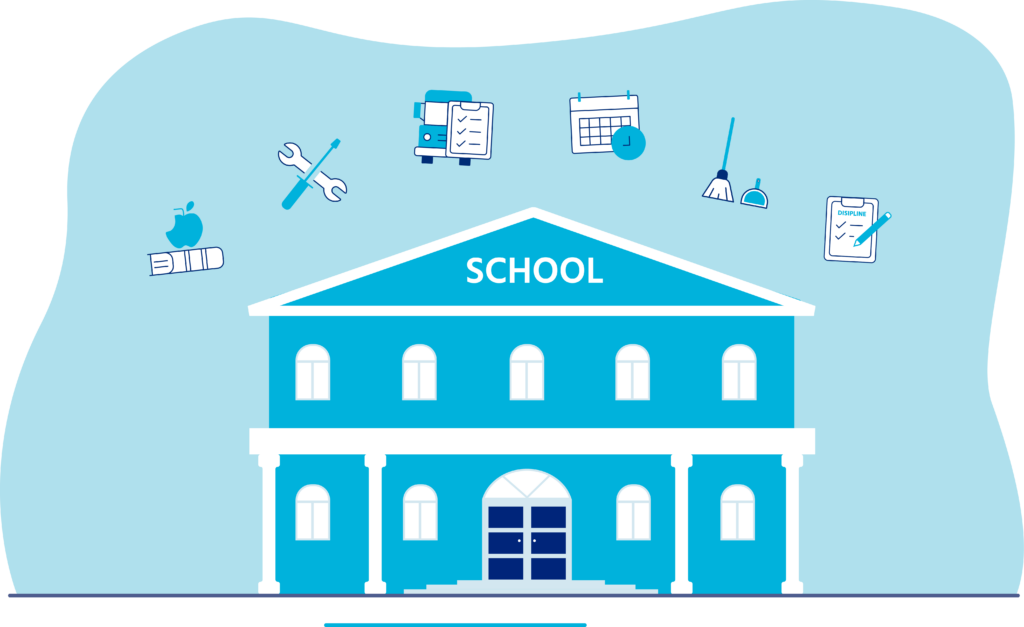Table of contents
As facility managers and dedicated school and district leaders, you understand assets’ critical roles in creating a conducive learning environment. Whether we’re talking about boilers, HVAC systems, or cafeteria refrigerators, efficiently managing these assets is key to maximizing their lifespan, ensuring regulatory compliance, and optimizing resource allocation.
But how can you ensure your management system makes the most of your assets?
To answer that question, we’ll need to look at the fundamentals of asset management in schools, the types of assets involved, the reasons for implementing asset management strategies, and the significant benefits they bring. Let’s dive in and discover how effective asset management can unlock efficiency in your school facilities.
What is school asset management?
Asset management in schools refers to the systematic approach of organizing, maintaining, and utilizing the various tangible and intangible resources owned by an educational institution.
These assets range from physical items like buildings, equipment, technology, and furniture to intangible assets such as intellectual property and software licenses. Asset management aims to ensure the optimal use, maintenance, and replacement of these assets throughout their lifecycle.
Depending on your needs and district size, your asset management system may log any or all of the following: asset data, asset locations, equipment service logs, maintenance work, total costs, inventory, and service scheduling.
Why is asset management necessary for schools?
Implementing asset management strategies in schools is vital for several reasons. Firstly, it ensures regulatory compliance by keeping track of assets, maintenance schedules, and safety protocols. Secondly, it optimizes resource allocation by identifying underutilized assets and reallocating them where needed.
Effective asset management minimizes downtime and disruptions by proactively maintaining assets, reducing repair costs, and extending asset lifespans. It also enhances accountability and transparency by providing accurate records of asset usage, maintenance history, and depreciation. In the end, all districts, however different in their administrative systems, aim to support their students and improve their schools.
An effective asset management system has the ability to create a safe and conducive learning environment for students, where well-maintained facilities and functional equipment support academic success. In short, it supports your goals and bolsters student success.
The benefits of implementing asset management in schools
Improve record-keeping
It can be overwhelming if you’re using paper or spreadsheets to track your assets. Districts track thousands of items, and it’s unreasonable to ask for them all to be tracked manually. Bringing it into a digital software system not only allows you to access asset information easily but it protects your asset history from fire, damage, and misplacement. This information is also accessible when an audit is requested.
Avoid spending on duplicate assets
Having access to your district’s entire asset repository allows you to see what’s currently in use and, more importantly, what’s not in use. Say there’s a request for more desks in a classroom. A digital asset system allows maintenance teams to see where desks aren’t being used in the school district. Instead of purchasing more, there may be an opportunity to take unused desks from other classrooms or schools.
Keep track of money spent on equipment maintenance
Asset tracking software automatically calculates spending associated with each asset, whether that be purchasing costs, repair costs, or otherwise. Each department can see how much their assets are costing them and ensure they stay within budget requirements.
Free K-12 PM Assessment Tool
Get personalized and actionable advice on how to improve your preventive maintenance practices.
Quickly locate assets
Thanks to interactive maps, you can easily locate an asset in your school building. This lets teams locate overdue assets, find missing supplies, and finally uncover where those missing lab frogs went.
Protect your 1:1 technology initiative
With asset management software, you can determine which students are paired with which devices and look up each student’s device usage history to drive a safe 1:1 technology initiative.
Make data-driven decisions regarding your assets
You can view how your assets are performing in an easy-to-consume report. While you may not need to check the performance of every single asset, some are going to be rather important:
Looking at the performance of these high-value items allows you to decide when it’s time to repair an asset, when it’s time to replace it, and when it needs an inspection.
Learn about other benefits associated with equipment maintenance software.
Commonly tracked school assets
While every school district has its unique assets, many share similarities.
Several large equipment items need serviced and maintained in schools. These assets can be costly and, if not kept up-to-date, can lead to uncomfortable learning environments, expensive repairs, and safety hazards. School equipment often includes:
- HVAC units
- Air handlings units
- Boilers
- Freezers and refrigerators
- Ovens and stoves
School buses, vans, and other forms of transport are also considered assets. These often require inspections and preventive maintenance performed at set mile intervals. If not cared for properly, this can cost the school thousands of dollars.
As I mentioned before, the use of IT assets is increasing rapidly in school districts. Many information technology (IT) departments use asset tracking systems to better track where technology is and which school inventory items are due for repair. Some of the most common IT assets include:
- Laptops
- Tablets
- Smartboards
- Printers
- Projectors
- 3D printers
Supplies are one of the most diverse groups of physical assets for a district. When you think of all the various items students use and consume daily, you start to realize just how overwhelming the list becomes. Other assets schools track include:
- Textbooks
- Stationery
- Cleaning supplies
- Sports equipment
- Art supplies
- Food for lunches
- Laboratory equipment
- And other physical inventory items
While these items are not nearly as expensive as equipment, fleet, or technology, not correctly tracking and managing these items can add up quickly. It’s essential to have a way to categorize and organize these items—otherwise, it can get out of hand.
Key principles and strategies for school asset management
An asset management system should support your efforts to gather data, record information, and make decisions for a brighter future. Speaking more tangibly, you should be able to utilize whatever program or methodology your district chooses to care for your assets and assess their value. That includes everything from creating planned maintenance requests to tracking emergency repair costs. As you consider the utilization of the asset management system at your school, keep these key principles in mind:
Inventory and tracking
The first step to school asset management is to gather information and keep accurate records of assets, including purchase dates, maintenance history, and depreciation values. Utilize asset tracking systems, barcoding, or RFID technology for efficient asset identification and tracking.
Plan maintenance
Develop a preventive maintenance schedule to proactively address asset issues and extend their lifespan. Regular inspections, cleaning, and servicing can prevent costly repairs and ensure optimal functionality.
Leverage data
Collecting and analyzing asset-related data empowers schools to make informed decisions about asset allocation, utilization, and investment. Key school and district planners can then leverage their data for effective decision-making.
Successful asset management in schools involves various strategies and methods. Whatever system you use, whether you rely on a spreadsheet, email chain, or software solution, consider what improvements you might make to better support your school.

School asset management software solutions through FMX
FMX’s school asset management software has been developed for K-12 facility managers, by K-12 facility managers. With a global user base encompassing hundreds of school districts, our trusted system simplifies asset tracking and maintenance processes with remarkable ease.
Our software solution can do so much more than manage your school’s assets, we can help with all of your operational needs, including:
- Asset and equipment management
- Work order management
- Preventive maintenance
- Facility scheduling
- Fleet maintenance and scheduling
- IT asset management
- Capital planning
Are you interested in learning more about FMX school asset management software? When you switch to our system, your dedicated customer success manager will work alongside you and provide the support you need to help you get the most out of your FMX site.
Request a demo today to get in touch with our team.
Written by
Dana Grove
Manager, Brand and Content at FMX
